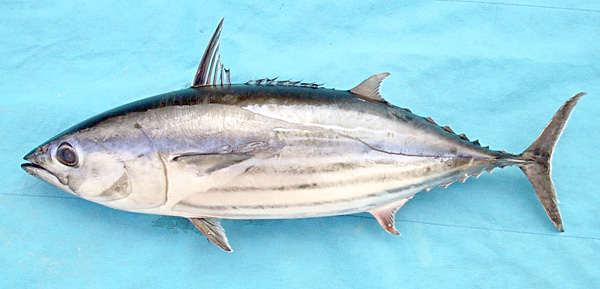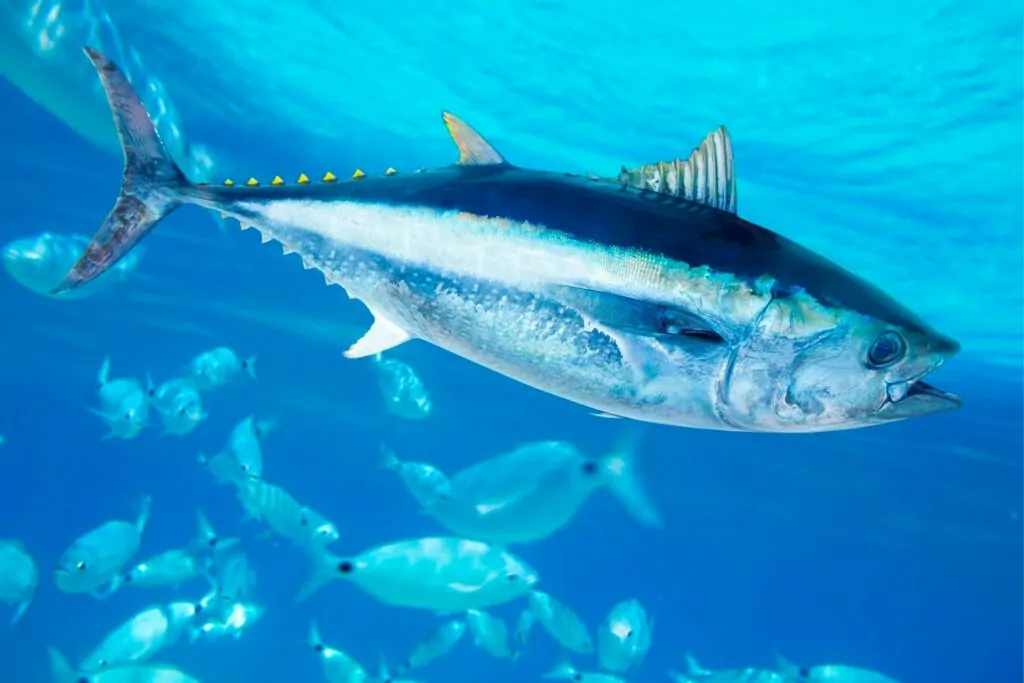Striped tuna (Katsuwonus pelamisSkipjack tuna, also known as skipjack tuna, is one of the most common types of tuna fish. It can be found in warm waters around the world, and thanks to its rapid growth and large numbers, it plays a key role in both marine ecosystems and the fishing industry.
This type of tuna is characterized by a striped belly color, incredible speed and significant productivity. Striped tuna is the most important commercial tuna species in the world – it makes up the majority of the total tuna catch and is used for canned food, sushi and other culinary products.
In this article, we will look at the biology, behavior, habitat, importance to fisheries, threats, and conservation measures of this unique species.

1. General characteristics of striped tuna
🔬 Scientific classification:
✔ The Kingdom: Animals (Animalia)
✔ Type: Chordal (Chordata)
✔ Class: Lucheperi pisces (Actinopterygii)
✔ Row: Perch-like (Perciformes)
✔ Family: Mackerel products (Scombridae)
✔ Gender: Katsuwonus
✔ View: Striped tuna (Katsuwonus pelamis)
📍 Habitat range:
✔ Tropical and subtropical waters of all oceans
✔ Atlantic, Pacific and Indian Oceans
It is most commonly found in the open ocean, but approaches the coast during migrations
📏 Sizes:
✔ Length: usually 40-80 cm, maximum-up to 1.1 m
✔ Weight: average 8-10 kg, maximum-up to 34 kg
📌 Interesting!
Striped tuna is growing very fast: within a year, it can reach Scales 3 kg!
🏃 Speed:
✔ Can swim at speeds up to 50 km / h
🌡 Temperature range:
✔ 18–30°C
2. Appearance and anatomy
🔹 Body:
✔ Streamlined, torpedo-shaped
✔ Powerful muscles for fast movement
🔹 Color scheme:
✔ Back-dark blue or dark purple
✔ Sides-silver
✔ Belly-silvery with 4-6 dark horizontal stripes
🔹 Fins:
✔ Two dorsal fins that help reduce water resistance
✔ Crescent-shaped tail fin-ideal for fast movement
📌 Unique Feature:
✔ Unlike other tuna, striped tuna doesn't have a swim bladder!

3. Lifestyle and behavior
🛶 Migrations:
Striped tuna make long migrations in search of food and favorable conditions for spawning
✔ It often migrates along with other tuna and mackerel species
🐟 Social structure:
✔ Lives in large schools (from 50 to 50,000 individuals)
✔ Often forms mixed groups with yellowfin tuna and other fish
4. Feeding and predatory behavior
🍽 Basic diet:
✔ Anchovies
✔ Sardines
✔ Squid
✔ Crustaceans
✔ Plankton
📌 Interesting!
Striped tuna is a voracious predator. His appetite is so great that he can eat up to 25% body weight per day!

5. reproduction and life cycle
🌊 Spawning grounds:
✔ Tropical open ocean waters
✔ Coastal areas with warm water
🕑 Spawning time:
✔ Occurs throughout the year in warm waters
✔ In temperate waters-in summer
🐟 Features of reproduction:
✔ The female lays up to 2 million eggs
✔ Larvae grow very fast and reach 30 cm per year
📌 Interesting!
Striped tuna lives on 5-7 years old.
6. industrial catch and threats
📉 Population decline:
✔ Striped tuna is one of the most commonly caught fish species in the world
✔ The main methods of catching-basket and longline.
⚖ Security measures:
✔ Setting catch quotas
✔ Protection of spawning grounds
✔ Using less invasive fishing methods
📌 Interesting!
Striped tuna is almost 60% of the total tuna catch in the world!
7. Role in the marine ecosystem
🌊 A mid-level predator:
✔ Controls small fish populations
✔ It is an important food source for sharks, dolphins and large tuna
⚠ Consequences of population decline:
✔ Food chain disruption
✔ Increase the number of small fish
8. Interesting facts about striped tuna
✔ One of the fastest growing tuna
✔ The most common type of tuna in canned food
✔ Often used in sushi and sashimi
✔ Avoids cold waters due to the lack of a temperature maintenance mechanism
Conclusion
Striped tuna (Katsuwonus pelamisIt is one of the most important tuna species in the global fishing industry. Due to its high abundance, rapid growth and wide distribution, it remains a key species in marine ecosystems.
However, due to the massive commercial catch, it is necessary to meet quotas and take a responsible approach to fishing in order to preserve the population of this unique tuna for future generations.